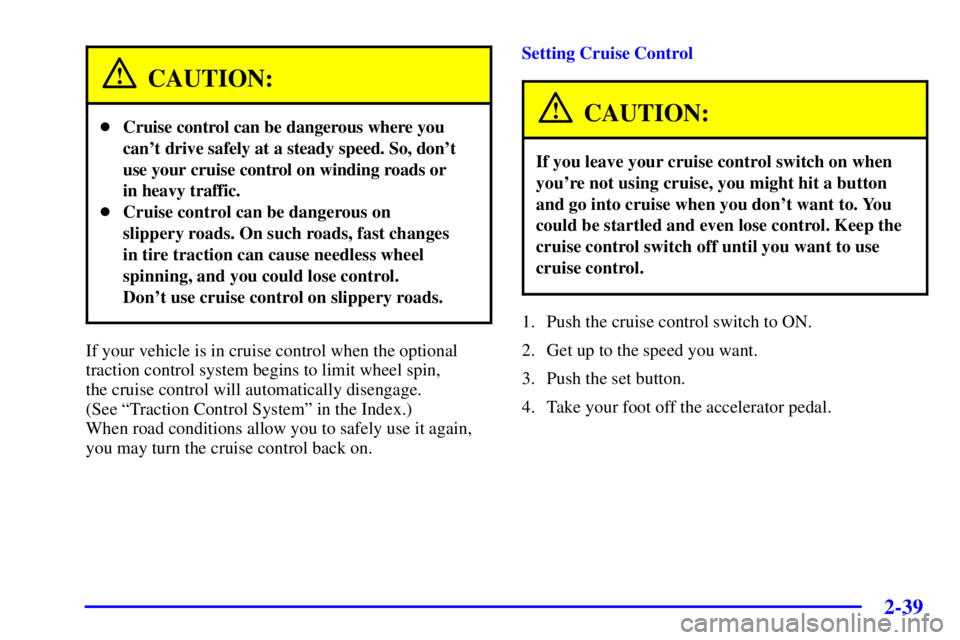Page 4 of 402
Table of Contents
Keys and Door Locks
Remote Keyless Entry System (If Equipped)
Trunk Release
Automatic Transaxle
Parking Brake
Windows
Tilt Wheel
Turn Signal/Multifunction Lever
Windshield Wipers
Cruise Control
Interior and Exterior LampsMirrors
Storage Compartments
Convenience Net (Option)
Accessory Power Outlet
Sunroof (Option)
HomeLink® Transmitter (If Equipped)
Instrument Panel, Warning Lights and Gages
Head-Up Display (Option)
Driver Information Center (Option)
Memory and Personalization Seats and Seat Controls
Safety BeltsAir Bag Systems
Child Restraints
Section
1
Section
2
Seats and Restraint Systems
Features and Controls
ii
Page 98 of 402
2-34
Tilt Wheel
A tilt steering wheel allows
you to adjust the steering
wheel before you drive.
You can also raise it to the highest level to give your
legs more room when you exit and enter the vehicle.
To tilt the wheel, hold the steering wheel and pull the
lever toward you. Move the steering wheel to a
comfortable level, then release the lever to lock the
wheel into place.
Turn Signal/Multifunction Lever
The lever on the left side of the steering column
includes your:
�Turn Signal and Lane Change Signals
�Headlamp High/Low
-Beam Changer
�Flash
-To-Pass Feature
�Cruise Control
�Manual Exterior Lamps Control
Page 102 of 402
2-38
Windshield Washer
At the end of the wiper lever, there's a button. To spray
washer fluid on the windshield, push the button until
you have enough fluid to clean the windshield. The
wipers will clear the window and either stop or return to
your preset speed.
CAUTION:
In freezing weather, don't use your washer until
the windshield is warmed. Otherwise the washer
fluid can form ice on the windshield, blocking
your vision.
A WASHER FLUID warning light will indicate if the
fluid level in the windshield washer reservoir is low. See
ªLow Washer Fluid Warning Lightº in the Index.
Cruise Control
With cruise control, you can
maintain a speed of about
25 mph (40 km/h) or more
without keeping your foot
on the accelerator. This can
really help on long trips.
Cruise control does not work at speeds below about
25 mph (40 km/h).
When you apply your brakes, the cruise control
shuts off.
Page 103 of 402

2-39
CAUTION:
�Cruise control can be dangerous where you
can't drive safely at a steady speed. So, don't
use your cruise control on winding roads or
in heavy traffic.
�Cruise control can be dangerous on
slippery roads. On such roads, fast changes
in tire traction can cause needless wheel
spinning, and you could lose control.
Don't use cruise control on slippery roads.
If your vehicle is in cruise control when the optional
traction control system begins to limit wheel spin,
the cruise control will automatically disengage.
(See ªTraction Control Systemº in the Index.)
When road conditions allow you to safely use it again,
you may turn the cruise control back on.Setting Cruise Control
CAUTION:
If you leave your cruise control switch on when
you're not using cruise, you might hit a button
and go into cruise when you don't want to. You
could be startled and even lose control. Keep the
cruise control switch off until you want to use
cruise control.
1. Push the cruise control switch to ON.
2. Get up to the speed you want.
3. Push the set button.
4. Take your foot off the accelerator pedal.
Page 104 of 402

2-40
Resuming a Set Speed
Suppose you set your cruise control at a desired speed
and then you apply the brake. This, of course, shuts off
the cruise control. But you don't need to reset it.
Once you're going about 25 mph (40 km/h) or more,
you can move the cruise lever up to R/A
(resume/accelerate) briefly.
You'll go right back up to your chosen speed and stay
there. Remember that if you hold the lever at R/A,
the vehicle will keep going faster until you release the
switch or apply the brake. So unless you want to go
faster, don't hold the lever at R/A.
Increasing Speed While Using Cruise Control
There are two ways to go to a higher speed.
�Use the accelerator pedal to get to the higher speed.
Press the SET button and then release it as well as
the accelerator pedal. You'll now cruise at the
higher speed.
�Push the cruise lever up to R/A. Hold it there until
you get up to the speed you want, and then release it.
To increase your speed in very small amounts,
move the switch to R/A briefly and then release it.
Each time you do this, your vehicle will go about
1 mph (1.6 km/h) faster.The accelerate feature will only work after you have set
the cruise control speed by pushing the SET button.
Reducing Speed While Using Cruise Control
There are two ways to reduce your speed while using
cruise control:
�Press the SET button.
�To slow down in very small amounts, press and
release the SET button briefly. Each time you do
this, you'll go 1 mph (1.6 km/h) slower.
Passing Another Vehicle While Using Cruise Control
Use the accelerator pedal to increase your speed. When
you take your foot off the pedal, your vehicle will slow
down to the cruise control speed you set earlier.
Using Cruise Control on Hills
How well your cruise control will work on hills depends
upon your speed, load and the steepness of the hills.
When going up steep hills, you may have to step on the
accelerator pedal to maintain your speed. When going
downhill, you may have to brake or shift to a lower gear
to keep your speed down. Of course, applying the brake
takes you out of cruise control. Many drivers find this to
be too much trouble and don't use cruise control on
steep hills.
Page 105 of 402

2-41
Ending Cruise Control
There are three ways to turn off the cruise control:
�Step lightly on the brake pedal,
�move the cruise switch to OFF, or
�push the cruise lever toward the driver.
Erasing Speed Memory
When you turn off the cruise control or the ignition,
your cruise control set speed memory is erased.
Exterior Lamps
Headlamps
See ªTurn Signal/Multifunction Leverº in the Index.
Daytime Running Lamps
Daytime Running Lamps (DRL) can make it easier for
others to see the front of your vehicle during the day.
DRL can be helpful in many different driving
conditions, but they can be especially helpful in the
short periods after dawn and before sunset.A light sensor on top of the instrument panel monitors
the exterior light level for the operation of DRL and
Twilight Sentinel
�, so be sure it isn't covered. The DRL
system will make your high
-beam headlamps come on
at a reduced brightness when:
�The ignition is on,
�the headlamp switch is off, and
�the transaxle is not in PARK (P).
When the DRL are on, only your high
-beam headlamps
will be on at reduced intensity. The taillamps,
sidemarker and other lamps won't be on. Your
instrument panel won't be lit either.
When it's dark enough outside, your regular intensity
headlamps will come on at full brightness and the DRL
lighting will turn off. The park lamps that normally
come on with your headlamps will also come on.
When it's bright enough outside, the regular intensity
headlamps and park lamps will turn back off, and the
reduced brightness DRL lighting will turn back on.
To idle your vehicle during the day with the DRL off,
shift the transaxle into PARK (P). The DRL will stay
off until you shift out of PARK (P).
At night, you can turn off all exterior lamps when you
are in PARK (P) by turning the Twilight Sentinel knob
all the way to OFF.
Page 213 of 402

4-9
Remember: Anti-lock doesn't change the time you need
to get your foot up to the brake pedal or always decrease
stopping distance. If you get too close to the vehicle in
front of you, you won't have time to apply your brakes
if that vehicle suddenly slows or stops. Always leave
enough room up ahead to stop, even though you have
anti
-lock brakes.
Using Anti
-Lock
Don't pump the brakes. Just hold the brake pedal down
firmly and let anti
-lock work for you. You may feel a
slight brake pedal pulsation or notice some noise, but
this is normal.
Braking in Emergencies
With anti-lock, you can steer and brake at the same
time. In many emergencies, steering can help you more
than even the very best braking.
Traction Control System
(If Equipped)
Your vehicle may have a traction control system that
limits wheel spin. This is especially useful in slippery
road conditions. The system operates only if it senses
that one or both of the front wheels are spinning or
beginning to lose traction. When this happens, the
system works the front brakes and reduces engine power
to limit wheel spin.
You may feel or hear the system working, but this
is normal.
If your vehicle is in cruise control when the traction
control system begins to limit wheel spin, the cruise
control will automatically disengage. When road
conditions allow you to safely use it again, you may
reengage the cruise control. (See ªCruise Controlº
in the Index.)
This light should come on
briefly when you start the
engine. If it stays on or
comes on while you are
driving, there's a problem
with your traction
control system.
Page 338 of 402
6-63
Minifuse Usage
9 Headlamp High Beam Right
10 Headlamp High Beam Left
11 Ignition 1
12 Not Used
13 Transaxle
14 Cruise Control
15 DIS
16 Injector Bank #2
17 Not Used
18 Not Used
19 Powertrain Control
Module Ignition
20 Oxygen Sensor
21 Injector Bank #1
22 Auxiliary Power
23 Cigar Lighter
24 Fog Lamps/Daytime
Running Lamps
25 Horn
26 Air Conditioning ClutchMirco Relay Usage
27 Headlamp High Beam
28 Headlamp Low Beam
29 Fog Lamps
30 Daytime Running Lamps
31 Horn
32 Air Conditioning Clutch
33 HVAC Solenoid
Mini Relay Usage
34 Accessory
35 Air Pump
36 Starter 1
37 Cooling Fan Secondary
38 Ignition 1
39 Cooling Fan Series/Parallel
40 Cooling Fan Primary